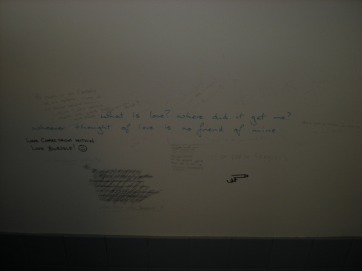Transferring Washroom Graffiti into the Digital Space
- The act of transferring washroom graffiti into the digital space was one that required patience, luck, and knowledge.
- First of all, one must go out in the physical world and visit a lot of washroom stalls in order to find washroom graffiti. This was extremely tiresome and at times, quite disgusting. Of course this depends on the level of sanitation of the washrooms. Often, due to legal laws and the negative connotation related to graffiti, finding washroom graffiti was also difficult. For example, the graffiti that sparked my interest in this project was one that was located in the SUB Basement. However, when I went there to look for it, I noticed that UBC has changed the doors in the particular washroom. As a result, the graffiti no longer existed. As a result, I had to be patient and go look for other washrooms, without knowing whether or not I would be able to find a graffiti-ed washroom that has a "narrative" to it.
- One had to be extremely lucky to find the correct type of washroom graffiti that invites conversation and provokes thoughts. I was in the UBC campus for at least 5 hours looking for the right type of graffiti, having to travel to every washroom that was available on campus. As a result, luck was a major factor that determined whether or not I would be able to find the desire graffiti work.
This type of graffiti does not invite conversation. It is not understandable by all and is not written in a language that is known to the general public.
Men's washroom stall located on the 2nd floor in Buchanan B at UBC (1866 Main Mall, Vancouver, BC) - Picture taken on July 17, 2010 by Anita Cheong
- After capturing the washroom graffiti, one must have the knowledge as to how he or she wants to transfer this graffiti act into the digital space. Originally, I used hyperlinks and "hotspots" that allowed one to explore the graffiti washroom. However, users had to put their mouse over these "hotspots", which were difficult to find due to the quality of the picture. An example of the original work can be found here.
- Being unsatisfied with the work, I began to learn HTML and JavaScript in order to enhance the readability of my digital bathroom graffiti, which resulted in a different type of reading. The reader can now move their mouse over certain graffiti comments and instantaneously see what the graffiti was saying. It also provided hyperlinks if the reader chooses to learn more about what is written on the graffiti wall.
- Through this process, I began to appreciate the importance of the marginalized author. Without knowing the language of HTML and JavaScript, I would not have been able to create a user friendly and graphically appealing reading of digital bathroom graffiti.


